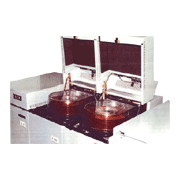After developing the Model 101 magnetic disk pack unit, the Electrical Communication Laboratories (ECL) of Nippon Telegraph and Telephone Public Corporation (now NTT) set a goal of achieving a linear recording density of 1,000 bit/mm (6 times the practical recording density at the time). They began full-scale research development in 1974 on issues such as magnetic disks incorporating thin-film, electromagnetic conversion in magnetic heads, recording/playback circuits, head floating mechanisms, positioner mechanisms, and packaging.
The need to increase the capacities of magnetic disk units was extremely urgent, and in 1976 NTT began full-scale research development on high-capacity magnetic disk units. In 1978, they achieved practical application of the Model 801 (JS4370) magnetic disk unit with a memory capacity of 800 MB/spindle. This unit had the following features.
- 1) It achieved a linear recording density of 340 bit/mm, track density of 26 tr/mm, and surface recording density of 9 Kbit/m2 (4 times the previous value). This was done by developing a thin-layer coated magnetic disk and a compact, high-sensitivity monolithic magnetic head.
- 2) A float gap of 0.36μm was achieved using a compact floating head slider with a length of 4.6 mm.
- 3) High-precision positioning control of ±1.5μm was achieved by developing a movable positioner weighing 650 g.
- 4) An average seek time of 20 ms was achieved via high-speed positioner seek.
- 5) A data transfer speed of 1.344 MB/s and a signal detection margin of 40% or more were achieved by developing a playback circuit using cosine equalization.


